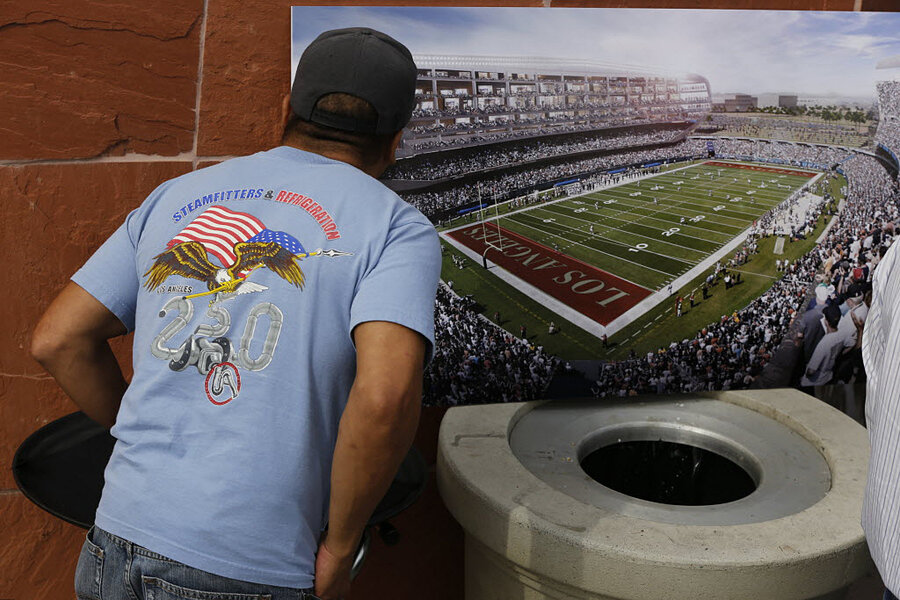NFL stadium proposal: Will pro football return to Los Angeles?
Loading...
Professional football has not been played in America's second largest media market since 1995 when the Raiders and the Rams still played in Los Angeles.
Is the City of Angeles on the brink of getting its first National Football League (NFL) team in two decades?
There's reason for some optimism. But if past is prologue, football fans should probably hold off on making any giant foam finger purchases yet.
On Tuesday night, the Carson city council members voted unanimously to approve $1.7 billion stadium proposal that would house both the San Diego Chargers and the Oakland Raiders in the suburb less than 20 miles from downtown Los Angeles, according to the Los Angeles Times. The proposal is lacking in some detail but it makes the claim that no taxpayer funds will be used. If true, that would be rare. Some also speculate that Carson rushed this proposal through to have it agreed upon in time for an NFL owners meeting in New York on Wednesday, according to the report.
And there's another L.A. stadium proposal being floated. St. Louis Rams owner Stan Kroenke has already launched a $1.82 million stadium proposal with a venue slated to be built in Hollywood Park in Inglewood, Calif. that is privately funded, the Los Angeles Times also reported.
The league has maintained that it would not permit any team to move before the start of the 2015 season. NFL rues require that 75 percent of the 32 owners need to approve any potential move, and the owners would be hard pressed to put it to a vote before the start of next season.
In the past 20 years, Los Angeles has missed several opportunities to secure a football franchise. A 2011 ESPN story profiled the the failed attempts to bring an NFL team back to the city, with perhaps the best chance coming in March 1999 when the league had tentatively awarded L.A. with the league's 32nd expansion franchise on the condition the city settled on one ownership group and a stadium site within six months. This venture ultimately failed and Bob McNair paid a record $700 million expansion fee to steal the franchise out from under L.A., bringing an NFL team to Houston that became the Houston Texans.
Here's how ESPN author Arash Markazi described the Los Angeles NFL quest:
There have always been competing groups and proposals, none anyone can agree on, and therefore none that have resulted in a team or a stadium.
In a city in which everyone wants a piece of the action, the insistence of developers and politicians to cling to their perceived piece of the action has left Los Angeles with no action to speak of on Sundays in the fall.
Los Angeles' pursuit of an NFL team has resembled an ongoing, never-ending, filibustering campaign between a myriad of candidates from various locales over the years. Instead of a unified group with a singular vision joined together by the common goal of bringing an NFL team to Los Angeles, the league has come to view L.A. as an endless caucus of talking heads with enough hollow promises to fill two decades worth of campaign speeches and enough meaningless artist renderings to fill a museum.
By leaving a hole in such a large market – where NFL games come on at 10 a.m, meaning fans in Los Angeles can get a full day's worth of football in and still go out for an evening on the town at roughly 9 p.m. – the league could leverage any of its teams' host cities into allocating money for stadium projects. NFL owners could operate with the explicit – or implicit – threat of moving their team to L.A., if their city refused to at least partially subsidize stadium construction or renovation.
And that's been an effective tactic.
Of the 13 stadiums built since the year 2000, only one did not use any public money for construction: MetLife Stadium, home to the New York Jets and Giants, according to a report by Conventions, Sports and Leisure International. That means taxpayers ponied up less than 40 percent of the cost of six of the 13 stadiums. Of the remaining seven, taxpayers were on the hook for at least 61 percent of the cost. The construction of the Cincinnati Bengals' Paul Brown Stadium topped the list, percentage-wise, for taxpayer burden – with 94 percent of the $425 million cost covered by the taxpayers and opened in 2000, according to the report.
The heftiest price tag the public paid to build a stadium was the Indianapolis Colts' Lucas Oil Stadium, which opened in 2008. Taxpayers paid for 86 percent of the nearly $620 million construction bill.
The Los Angeles market already supports two teams for each of the three other major professional sports with the Los Angeles Dodgers and Los Angeles Angels of Anaheim of Major League Baseball, the Los Angeles Lakers and Clippers of the National Basketball Association, and the Anaheim Ducks and Los Angeles Kings of the National Hockey League.
Does that mean the L.A. market is too saturated to support another professional sports franchise? Few are making that argument.






